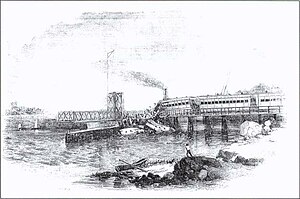This article needs additional citations for
verification. (September 2014) |
| Norwalk rail accident | |
|---|---|
 Originally titled "The Catastrophe", the illustration depicts the accident site | |
| Details | |
| Date | May 6, 1853 |
| Location | Norwalk, Connecticut |
| Country | United States |
| Line | New York and New Haven Railroad |
| Incident type | Movable bridge open |
| Cause | Signal passed at danger |
| Statistics | |
| Trains | 1 |
| Passengers | 200 |
| Deaths | 48 |
| Injured | 30 |
The Norwalk rail accident occurred on May 6, 1853, in Norwalk, Connecticut, and was the first major U.S. railroad bridge disaster; 48 were killed when a train travelling at 50 miles per hour (80 km/h) plunged into the Norwalk Harbor off of an open swing bridge. [1]
The accident occurred on the New York and New Haven Railroad where it crosses a small inlet of Long Island Sound via a swing bridge. The approach from New York is around a sharp curve, so there was a signal indicating if the bridge was passable by trains: a red ball mounted upon a tall pole.
At 08:00 that morning, the Boston express left New York with 200 passengers driven by a substitute driver for whom this was the third transit of the route. The train consisted of two baggage and five passenger cars. On approaching the bridge, the driver neglected to check the signal and only became aware that the bridge was open when within 400 feet (120 m) of it. The bridge had been opened for the passage of the steamship Pacific, which had just passed through. The driver applied the brakes and reversed the engine, but was unable to stop in time. He and the fireman leapt clear before the bridge and escaped serious injury. The engine itself flew across the 60-foot (18 m) gap, striking the opposite abutment some 8 feet (2.4 m) below the level of the track and sinking into 12 feet (3.7 m) of water. The baggage cars came to rest atop the locomotive; the front of the first passenger car was crushed against the baggage cars and then submerged as the second passenger car came to rest on top of it. The third passenger car broke in two; the front half hanging down over the edge of the abutment; the rear remaining on the track. Most of the 48 dead and 30 injured were in the first passenger car. A further eight people were reported missing.
Many doctors were travelling on the train, returning from the Sixth Annual Meeting of the American Medical Association in New York; seven of them were killed. Amongst the unhurt was Dr. Gurdon Wadsworth Russell, who wrote an account of the accident for the Hartford Courant in which he says that the dead "presented all the symptoms of asphyxia from drowning, and were probably drowned at once, being confined and pressed by broken cars. Oh, what a melancholy scene that!"
The coroner's jury found the engineer primarily responsible for the disaster, and he was prosecuted for manslaughter, but acquitted. [2]
As a result of the public panic and indignation caused by the accident, a bill was introduced in the Connecticut Legislature establishing a powerful state Board of Railroad Commissioners. However, in the version actually enacted, the board's enforcement powers were removed, as well as a requirement that every train in the state would have to come to a dead halt before crossing any opening bridge. The railroad, however, adopted such a policy on its own. [3]
A similar accident occurred eleven years later in Canada with even greater loss of life, the St-Hilaire train disaster.
References
- "Norwalk, CT Train Wreck, May 1853". GenDisasters.com. Archived from the original on 2014-01-08. Retrieved 2010-08-05.
- Mallery, Timothy J. "The Norwalk Accident". The Catskill Archive.
- "Dr. Gurdon Wadsworth Russell's Account of the 1853 Railroad Accident at Norwalk, Connecticut" (PDF). Archived from the original (PDF) on June 2, 2010.
- ^ Haine, Edgar A. (1994). "The first of many railroad bridge disasters: South Norwalk, Conn–May 1853–56 dead". Railroad Wrecks. Associated University Presses. p. 34. ISBN 9780845348444 – via Google Books.
- ^ Rob (no surname shown). "Norwalk Bridge Disaster. May 6th, 1853. The Nation's First Bridge Disaster".
- ^ Wesley S. Griswold (1969). Train Wreck! The story of 19 historic rail disasters: 1833–1958. Stephen Greene Press, Brattleboro, Vermont. p. 16. SBN 8289-0099-X.
- Railway accidents and incidents in Connecticut
- Bridge disasters in the United States
- Bridge disasters involving open moveable bridges
- Railway accidents in 1853
- 1853 in Connecticut
- History of Norwalk, Connecticut
- Accidents and incidents involving New York, New Haven and Hartford Railroad
- Long Island Sound
- Railway accidents involving a signal passed at danger
- May 1853 events
- Rail accidents caused by a driver's error
- Events in Fairfield County, Connecticut